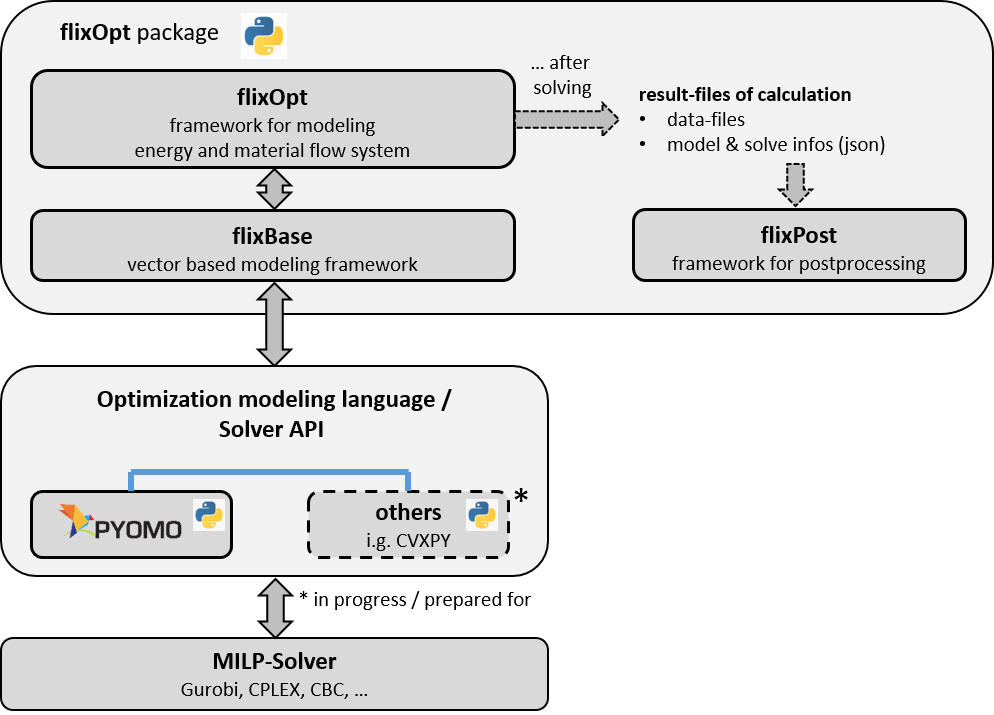flixOpt
Energy and Material Flow Optimization Framework
Model, optimize, and analyze complex energy systems with a powerful Python framework designed for flexibility and performance.
Quick Navigation¶
🚀 Getting Started
New to FlixOpt? Start here with installation and your first model
💡 Examples Gallery
Explore real-world examples from simple to complex systems
📚 API Reference
Detailed documentation of all classes, methods, and parameters
📖 Recipes
Common patterns and best practices for modeling energy systems
∫ Mathematical Notation
Understand the mathematical formulations behind the framework
🛣️ Roadmap
See what's coming next and contribute to the future of FlixOpt
🏗️ Framework Architecture¶

FlixOpt provides a complete workflow for energy system optimization:
- Define your system using Python components
- Optimize with powerful solvers (HiGHS, Gurobi, CPLEX)
- Analyze results with built-in visualization tools
- Export to various formats for further analysis
Community & Support¶
Recent Updates¶
What's New in v3.0.0
Major improvements and breaking changes. Check the Migration Guide for upgrading from v2.x.
📋 See the full Release Notes for detailed version history.
Ready to optimize your energy system?
FlixOpt: Energy and Material Flow Optimization Framework¶
FlixOpt is a Python framework for optimizing energy and material flow systems - from district heating networks to industrial production lines, from renewable energy portfolios to supply chain logistics.
Start simple, scale complex: Build a working optimization model in minutes, then progressively add detail - multi-period investments, stochastic scenarios, custom constraints - without rewriting your code.
🚀 Quick Start¶
That's it! FlixOpt comes with the HiGHS solver included. You're ready to optimize.
The basic workflow:
import flixopt as fx
# 1. Define your system structure
flow_system = fx.FlowSystem(timesteps)
flow_system.add_elements(buses, components, effects)
# 2. Create and solve
calculation = fx.FullCalculation("MyModel", flow_system)
calculation.solve()
# 3. Analyze results
calculation.results.solution
Get started with real examples: - 📚 Full Documentation - 💡 Examples Gallery - Complete working examples from simple to complex - 🔧 API Reference
🌟 Why FlixOpt?¶
Progressive Enhancement - Your Model Grows With You¶
Start simple:
# Basic single-period model
flow_system = fx.FlowSystem(timesteps)
boiler = fx.Boiler("Boiler", eta=0.9, ...)
Add complexity incrementally: - Investment decisions → Add InvestParameters to components - Multi-period planning → Add periods dimension to FlowSystem - Uncertainty modeling → Add scenarios dimension with probabilities - Custom constraints → Extend with native linopy syntax
No refactoring required. Your component definitions stay the same - periods, scenarios, and features are added as dimensions and parameters.
→ Learn more about multi-period and stochastic modeling
For Everyone¶
- Beginners: High-level components that "just work"
- Experts: Full access to modify models with linopy
- Researchers: Quick prototyping with customization options
- Engineers: Reliable, tested components without black boxes
- Students: Clear, Pythonic interfaces for learning optimization
Key Features¶
Multi-criteria optimization: Model costs, emissions, resource use - any custom metric. Optimize single objectives or use weighted combinations and ε-constraints. → Effects documentation
Performance at any scale: Choose calculation modes without changing your model - Full, Segmented, or Aggregated (using TSAM). → Calculation modes
Built for reproducibility: Self-contained NetCDF result files with complete model information. Load results months later - everything is preserved. → Results documentation
Flexible data operations: Transform FlowSystems with xarray-style operations (sel(), resample()) for multi-stage optimization.
🎯 What is FlixOpt?¶
A General-Purpose Flow Optimization Framework¶
FlixOpt models any system involving flows and conversions:
- Energy systems: District heating/cooling, microgrids, renewable portfolios, sector coupling
- Material flows: Supply chains, production lines, chemical processes
- Integrated systems: Water-energy nexus, industrial symbiosis
While energy systems are our primary focus, the same foundation applies universally. This enables coupling different system types within integrated models.
Modern Foundations¶
Built on linopy and xarray, FlixOpt delivers performance and transparency. Full access to variables, constraints, and model structure. Extend anything with native linopy syntax.
Our Position¶
We bridge the gap between high-level strategic models (like FINE) and low-level dispatch tools - similar to PyPSA. FlixOpt is the sweet spot for detailed operational planning and long-term investment analysis in the same framework.
Academic Roots¶
Originally developed at TU Dresden for the SMARTBIOGRID project (funded by the German Federal Ministry for Economic Affairs and Energy, FKZ: 03KB159B). FlixOpt evolved from the MATLAB-based flixOptMat framework while incorporating best practices from oemof/solph.
🛣️ Roadmap¶
FlixOpt aims to be the most accessible, flexible, and universal Python framework for energy and material flow optimization. We believe optimization modeling should be approachable for beginners yet powerful for experts, minimizing context switching between different planning horizons.
Current focus: - Enhanced component library (sector coupling, hydrogen, thermal networks) - Examples showcasing multi-period and stochastic modeling - Advanced result analysis and visualization
Future vision: - Modeling to generate alternatives (MGA) for robust decision-making - Advanced stochastic optimization (two-stage, CVaR) - Community ecosystem of user-contributed components
🛠️ Installation¶
Basic Installation¶
Includes the HiGHS solver - you're ready to optimize immediately.
Full Installation¶
For additional features (interactive network visualization, time series aggregation):
Solver Support¶
FlixOpt supports many solvers via linopy: HiGHS (included), Gurobi, CPLEX, CBC, GLPK, and more.
🤝 Contributing¶
FlixOpt thrives on community input. Whether you're fixing bugs, adding components, improving docs, or sharing use cases - we welcome your contributions.
📖 Citation¶
If FlixOpt supports your research or project, please cite:
- Main Citation: DOI:10.18086/eurosun.2022.04.07
- Short Overview: DOI:10.13140/RG.2.2.14948.24969
📄 License¶
MIT License - See LICENSE for details.












